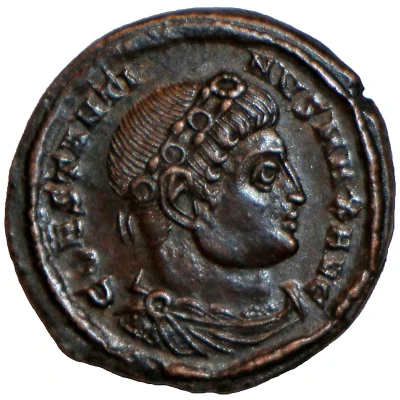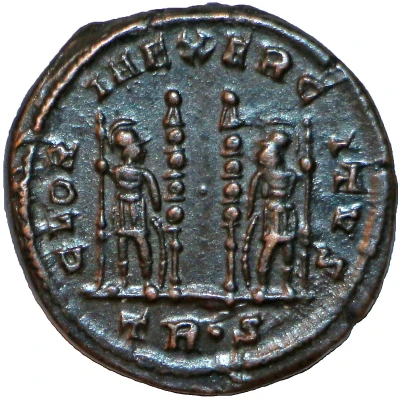Nummus - Constantinus II GLORIA EXERCITVS; Two standards; Lugdunum
332 year| Bronze | 2.15 g | 17 mm |
| Issuer | Rome › Roman Empire (27 BC - 395 AD) |
|---|---|
| Emperor | Constantine II (337-340) |
| Type | Standard circulation coin |
| Year | 332 |
| Value | Nummus (1⁄7200) |
| Currency | Solidus, Reform of Constantine (AD 310/324 – 395) |
| Composition | Bronze |
| Weight | 2.15 g |
| Diameter | 17 mm |
| Thickness | 1.7 mm |
| Shape | Round (irregular) |
| Technique | Hammered |
| Orientation | Coin alignment ↑↓ |
| Demonetized | Yes |
| Updated | 2024-10-05 |
| Numista | N#383908 |
|---|---|
| Rarity index | 87% |
Reverse
Two soldiers, helmeted, draped, cuirassed, standing facing each other, each holding reversed spear in outer hand and resting inner hand on shield; between them, two standards.
Star before officina and mintmark in exergue.
Script: Latin
Lettering: GLORIA EXERCITVS
Unabridged legend: Gloria Exercitus
Translation: Glory of the Army
Edge
Plain
Interesting fact
The Nummus - Constantinus II (GLORIA EXERCITVS; Two standards; Lugdunum) (332) coin was part of a large-scale currency reform implemented by Emperor Constantine II in the early 4th century AD. This reform aimed to standardize the weight and purity of Roman coins, which had previously varied widely, and to introduce a new system of denominations. The Nummus coin was one of the new denominations introduced by Constantine II, and it was intended to be a small, bronze coin with a standardized weight and value. Despite its small size, the Nummus coin played an important role in the Roman economy, as it was widely used for everyday transactions and was an important symbol of the Roman Empire's power and influence.

